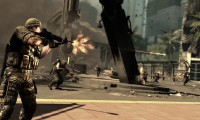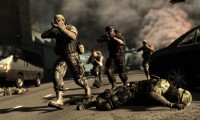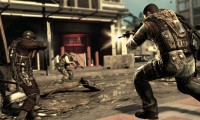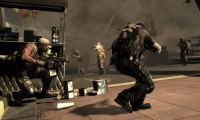
The SOCOM series was a mainstay of the PS2 era. Ushering in unprecedented competitive online and squad play on consoles, the games were multiplayer war before Modern Warfare was multiplayer war. I played enough of SOCOM 2 and 3 to know that the games were more than just “capture the flag”. They were about refinement, meticulous attention to detail, and exciting team-based play.
SOCOM 4 seems no different, though playing it with the MOVE controller brings an entirely new mechanic to the mix.

Tucked in a corner of Sony’s booth at E3 was a quad of MOVE demo areas focusing mostly on core games. I had asked to see SOCOM 4 as I felt it was a cornerstone of Sony’s motion pitch to the hardcore crowd. The game was being played on a 42″ screen, and I had ample room to stretch out on the couch should any flailing be needed.
My first impression was that the game had some of the most realistic environment in a modern-setting shooter since, well, Modern Warfare 2. In this case, what impressed me most wasn’t necessarily the characters or the vehicles, but the dirt and debris strewn around the concrete jungle of a major city. It added a new level of 3-dimensionality to the ground beyond just rocks and hills.
There’s a certain human element to the characters that I found interesting. While I only really played one stage, and hardly touched on the plot, their interaction as I sent them forward to destinations (by using the control pad to call out a location) made me genuinely worry if they were going to survive the oncoming fire or not. I was much more cautious in how I utilized them, opting not to send them out in a suicidal Zerg rush like in other squad shooters. As we ran across an overpass, I had my squad consistently seek out shelter behind overturned trucks and cars, as opposed to sending them to the center of the action. In fact, it plays much like a multiplayer co-op game, but with smart AI substituting the human players.
In SOCOM, you really do need to take care of your team.

The single-player demo was played with the MOVE and Sub-controllers. The MOVE controls seemed a bit slow. Pointing and aiming took some time, not to get used-to, but to get to where I wanted to aim. The aiming area was set in a zone in the center of the screen, and in order to rotate my character I had to point towards the edges. This mechanic was fine when I was parked behind an obstacle, but as soon as I needed to run and shoot it didn’t work as well.
Motion controls tend to be great for “close, but not exact” shooting. SOCOM, a game of precision and planning, needs more precise aiming. The controls seemed a bit like a marketing bullet point on the back of a box, as if the game was created initially without them. As MOVE comes to stores later this year, Sony may push for it to become more a focus in the game.
It was much like the first Conduit game, in fact. While the SOCOM 4 controls didn’t feel as refined as Conduit 2, they worked fine in some key situations. I hope the Zipper devs went to the Sega booth to see Conduit 2, though, as it may help influence the refinement here as well.
Overall, the demo was actually quite refreshing, providing something different in comparison to the other modern war shooters that were quickly filling the show floor. A lot of work clearly went into putting the experience together, from the situational aspect of the plot, to the push for a more team-oriented experience. SOCOM 4 drops this Fall.
[All images courtesy Zipper Interactive/Sony]









No Comments